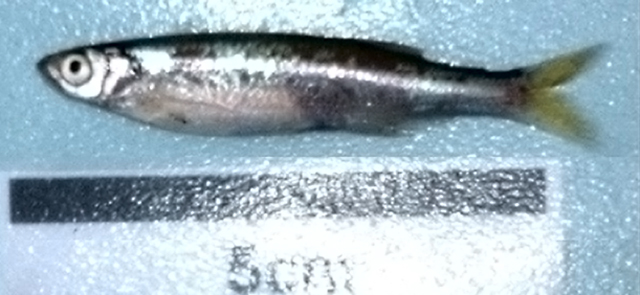|
Dorsal soft rays (total): 9-11; Anal soft rays: 16-19. Diagnosis: body strongly compressed (Ref. 34290), body height 4.25-4.75 times in body length, caudal peduncle twice as height as long (Ref. 42448). Lower jaw slightly prominent (Ref. 55057). Mouth large, terminal and rather oblique, without lips or circumoral barbels (Ref. 34290), extending to below anterior border of eye (Ref. 1872, 2988, 31439). Cheek largely covered by thin suborbital bones (Ref. 2988, 31439, 34290). Branchiospines rather short but not rudimentary; pharyngeal teeth conical (Ref. 55057). Gill rakers moderately long (Ref. 2988, 31439), 16 on (lower part of) first branchial arch (Ref. 2988, 4903, 31439). Scales moderately large, 42-56 on lateral line (Ref. 34290). Lateral line descending from about upper part of gill opening to just before ventral-fin origin (Ref. 42005, 55057), more or less following the ventral body profile from ventral fin to caudal peduncle (Ref. 34290, 55057). Dorsal fin situated almost entirely above anal fin (Ref. 34290). Anal-fin base about twice as long as dorsal-fin base (Ref. 4967). 12-17 branched anal-fin rays (Ref. 4903, 34290). Pectoral fin not reaching pelvic fin (Ref. 2988, 4967, 31439, 55057). Body silver with an overall nacreous sheen (Ref. 4903, 34290), yellowish brown above (Ref. 31439). Caudal fin yellow (Ref. 2988¸4903, 31439, 34290), other fins colourless (Ref. 4903, 34290), white or greyish (Ref. 2988, 31439). Dead specimens with a distinct mid-lateral stripe (Ref. 4903, 34290), stripe silver in life (Ref. 4967).
Description: small tubercles on head absent or confined to lower jaw (Ref. 83898). Snout pointed (Ref. 2988, 36900), not projecting beyond mouth (Ref. 2988). Maxillary reaching front edge of eye; lips narrow, thin, little fleshy; interorbital broadly convex; suborbitals broad, covering cheek to preopercular ridge; gill rakers 3+14, slender, lanceolate (Ref. 42005). 1-2 scales between lateral line and pelvic fin (Ref. 2988, 42005, 55057). 2 scales between lateral line and anal fin; 31 predorsal scales; small scales on chest, breast and belly; 3 scales on caudal-fin base; scales on body all narrowly imbricated (Ref. 42005). 8.5-9.5 scales above lateral line (Ref. 2988), Scale striae not distinct (Ref. 31439), 5-8 very short, marginal, basal striae and 2-4 little longer ones apically; circuli fine, basal, less distinct apically (Ref. 42005). 11-16 gill rakers on lower limb of first arch (Ref. 125995). Dorsal fin ii-7 to iii-7 (Ref. 2988, 31439, 42005), possibly followed by another unbranched ray, simple rays entire (Ref. 42005), first branched ray longest (Ref. 2988, 31439), little flexible (Ref. 42005). Anal fin with 2-3 unbranched rays, 13-16 branched rays (Ref. 2988, 31439, 42005), possibly followed by another unbranched ray, simple rays slender, smooth, longest little flexible (Ref. 42005). Caudal fin deeply forked (Ref. 2988, 42005), long, slender lobes sharply pointed; pectoral fin i-8; pelvic fin i-6 (Ref. 42005). Pectoral fin acutely pointed (Ref. 2988).
Coloration: Life specimens: body silver with an overall nacreous sheen (Ref. 4903, 34290), yellowish brown above (Ref. 31439). Caudal fin yellow-orange (Ref. 2988, 4903, 4967, 31439, 34290), other fins colourless (Ref. 4903, 34290), white or greyish (Ref. 2988, 31439). Flanks with silver stripe (Ref. 4967). Preserved specimens: back brown, edge of each scale dotted with blackish; gray underlaid lateral band, axial, wider and more conspicuous on side of tail and caudal peduncle; head, including end of lower jaw, dusted with dark or blackish brown; iris gray, evidently pale in life; fins brownish, lower ones paler to whitish (Ref. 42005). |
